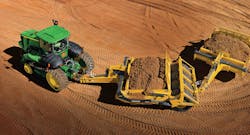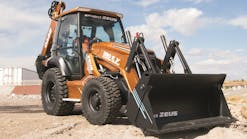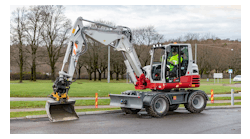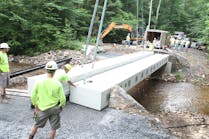Pull-type scrapers are efficient dirt movers on cut-and-fill jobs with short hauls. In addition to allowing the tow vehicle to become a multi-use onsite tool, these smaller scrapers also provide other beneficial features that enhance and facilitate performance.
“A lot of companies switch to a tractor with a pan scraper because they use the tractor for other things,” states Warren Waggoner, owner and president of Waggoner Inc. Newline Construction and Excavation. “It gives them added versatility.”
He owns two 1150 ejection scrapers from Garfield Equipment, with hydraulically operated rear gates that use forward-forced straight ejection for a smooth, even spread of material at the desired depth. “They give you the most bang for your buck,” Waggoner says. Four years ago he paid $22,000 apiece, which he contrasts to others in the class.
An added benefit is that “fuel efficiency is so much better with drag scrapers,” Waggoner claims, adding that if the tractor is big enough to pull two scrapers, efficiency is even greater, for manpower as well as fuel. As a small contractor, Waggoner says he monitors fuel consumption closely.
The Lawton, OK-based contractor specializes in large-scale earth moving jobs for both the residential and commercial markets. Some recent and current jobs he’s tackled include creating roads and a small lake for a park as part of Phase IV at Dove Creek Development; new streets, a lake, and a park for Scissortail Gated Community; site work, water retention, and storm sewer work for a new TSC dealership; and a “dirt-heavy” project on the 20-acre site of a future Jim Glover dealership. “We’re moving 70,000 yards of dirt in 70 days to build this dealership,” Waggoner says. “That creates a lot of wear on cutting edges, tires and the cylinder hose.”
There’s even more wear from some of his jobs in Texas because of an excess of rocky dirt. But because Garfield is local for Waggoner, parts are easy to get. They’re also economical. “Repair, parts and maintenance are half the cost of [other brands],” he indicates. “Their scrapers are built well and don’t cost as much to operate.”
He says he chose them because they provide the best price per yard. “We can move three times more dirt with a pan than with a motorized scraper. The only benefit of a Cat motorized 613, 623 or 628 is longevity: they’ll run 10,000-12,000 hours because they’re built heavy, but they cost $500,000.” Having used the Garfield scrapers for about 10 years, Waggoner says it’s “amazing the difference in the amount of dirt you move.”
For a company that’s “keeping it lean” with few employees and minimal expenses, efficiency is important. They’re “easy to work on and easy to run,” Waggoner sums up, even as he submits another reason he chose Garfield: “They listen to us about potential improvements, such as pin placement and wear points. They want to build the best possible scraper.”
Inspired Innovation
Garfield isn’t the only company striving to reach “best in class” status. Since 1917, when the company made horse-drawn scrapers, Miskin Scraper Works Inc., in Ucon, ID, has been incorporating innovation to build the best possible scraper. “Our customers are dealers who sell to contractors doing heavy highway work or site work for airports and golf courses,” says current owner and grandson of the founder, Mark Miskin. “A lot of them already carry tractors, so with the scrapers, it makes for a complete package.”
In the ongoing quest to improve products and introduce new ones to address the evolving work environment and take advantage of emerging technology, Miskin introduced new products at ConExpo in March. Its 20C is a 20.3-yard scraper for the construction market featuring hydraulic lines situated inside the frame for protection from rugged work environments. “Most of our competitors use guards and shields,” Miskin explains. “They can fall off.”
It’s a “different approach,” he continues. With each scraper in a train having its own lines, the connection area can become crowded or even entangled. This design simplifies and protects the lines, with panels for easy access during routine maintenance. Despite the large size, with a 12-foot cut, the unit bolts together for shipping. “We can fit two in a standard 40-foot ocean
container.”
Another new product that attracted a lot of attention at ConExpo is Miskin’s drop-in water tank. “Often, tanks are brought back from the junkyard,” Miskin conjectures. “They aren’t reliable.” Instead, he offers a new tank made of Cor-Ten weathering steel (anti-corrosion steel) that drops in the scraper, eliminating the need for a separate, dedicated machine. “Tanks usually have to be put on the frame,” he explains. “They’re self-propelled. That’s expensive.” Available in different sizes to fit a variety of scrapers, Miskins’ tank can be switched out quickly. Its pumps run off the tractor’s hydraulics.
But Miskin’s biggest innovation is its American-built air-assisted scraper loading system, also introduced at ConExpo. “It’s different technology,” he says. “Typically, a scraper loads up with dirt from dragging. The dirt inside is too heavy and dense, so it pushes out the front. This blasts compressed air up through the floor to loosen the material and allow more in. It changes the density of the dirt so more dirt can enter the bowl.”
An onboard tank, filled by a compressor when the tractor is transporting, provides the compressed air. When the tractor begins loading the scrapers, the operator turns off the compressor to give all available horsepower to the loading operation. When the load is finished, the operator hits the “air blast” button, sending a large blast of air up from the bottom of the bowl.
Miskin got the idea while watching a Discovery Channel show about WWII ships sunk by explosives that sent up bubbles to change the density of the water, creating turbulence that rendered the water incapable of supporting the weight of the ship. He adapted the technology to work on different sizes of scrapers, although he explains that he selected specific models and strengthened the frames, adding higher side boards to enable them to “load more of the heavier materials like sand and carry more weight than the scraper is designed to carry.”
Heavy Hauling
Carrying a lot of dirt expedites site work, so it’s an important feature for a scraper. Jim Juncker, general manager for Juncker Brothers in Mount Vernon, IN, a Case and Ashland dealer, expects the new Ashland 20-yard scraper that debuted at ConExpo to be in demand. “We do carry smaller pans, but we market to large contractors who do bulk earth moving for landfills, power companies and highway construction. They want something with more capacity. They want something durable and big enough to keep production up.”
His customers like the I-180, a heavy industrial 18-yard ejector scraper for heavy clay and hard-to-extract material. He likes Ashland’s responsiveness. “They’re open to improving their products,” Juncker says. “They’re very quick to respond to feedback to make them better and they can implement changes in weeks.” Adaptations have been made by adding hose couplers on the back, including brackets, altering shieldings and making changes to the hose stand on the front.
Another change required no physical adaptation of the machine. Recognizing the need to move more dirt economically and efficiently, Ashland Industries Inc. announced a marketing alliance with Case IH at ConExpo. The pairing of a heavy-duty Case IH tractor with an Ashland pull-type scraper is designed to move more dirt at the lowest possible cost-per-yard, according to Randy Rust, president/partner of Ashland Industries. “The Case IH tractor with a pull-type scraper system can provide up to a 30% to 40% cost-per-yard advantage, when compared with conventional self-propelled scrapers, especially on sites with short- to medium-haul distances.”
Even better results can be expected on labor and fuel because the Case IH tractor and scraper combination requires no dozer or other support equipment to follow behind. Additionally, the scraper is easily trailered for moving from site to site.
Working together, the tractor and pull-type scraper comprise a cost-effective earthmoving system that can load, transport, dump, and spread dirt evenly. Because Case IH tractors have enough power to pull multiple scrapers in tandem, this combination is efficient, and since the tractor can pull other equipment when the scraper is not in use, the versatility of this combination is an asset to a contractor’s inventory.
Juncker considers it invaluable in his equipment lineup. The family-owned dealership opened in 1956, initially selling farm equipment. In 2001, it introduced commercial scrapers, with pull-behind scrapers added later. After carrying Ashland and another brand in its rental fleet, Juncker says the company considered Ashland a superior product, requiring less maintenance and less downtime. “The key [for a contractor] is no downtime.”
Small but Rugged
Downtime is often talked about, usually with a sense of dread-if not fear-but another way of measuring time is by efficiency. If one piece of equipment can stretch beyond its inherent capabilities to perform additional functions, it saves a contractor time and money.
When Jim Beuter owned a turf-seeding business in Perry, IA, he needed something that would carry dirt and match his 55-horsepower tractor. He chose a DB6 from Hoelscher Inc., in Bushton, KS, because it hauls up to 1.8 cubic yards and can be pulled with a 45- to 50-horsepower tractor. “I had a JD2355 tractor,” he recalls. “The hydraulics are just right [for the scraper].”
The scraper was just right too. “I had other scrapers first-box scrapers,” Beuter says, but he preferred the Hoelscher dump bowl with the 6-foot cutting width. The core of his business was fine grading and seeding for residential customers, so the smaller size was more suitable. “I did a lot of finish grading. The scraper can get right next to a house to dump dirt; the wheel space and axle length are the same width as the scraper, so it’s easy to back into tight spots. I could haul dirt and meter it out to get the right thickness.”
The ability to accurately meter dirt was particularly important on a job Beuter did for a high-school sports complex. The 20-acre site included baseball and softball diamonds and a driving range. “It was very precise work,” he says. “We moved dirt to get the basic slope, then used a grader for finish grading.” With the scraper, he excavated 12 inches in center field, replacing it with a mixture of sand and soil to improve drainage. “Drainage is a problem on ball diamonds. With this design, you can play on it one hour after a rain.”
Because Beuter knew how many yards the scraper held, he was able to use it as a way to measure and layer the soil mixture, calculating meticulously to meet specifications. “We calculated each layer, the number of dumps of sand, soil, and turfs. If we didn’t do it right the first time, we’d have to tear it out and start over. The public was watching.” Bad weather didn’t help, but his crews worked day and night and the equipment held up. “[Hoelscher] has good engineering and workmanship.”
One thing that helped was the hydraulics, which he said provided accurate metering and flow. An apron helped meter correctly-an apron he didn’t initially purchase. “I bought the scraper from the John Deere dealer without the apron, but later I called Hoelscher directly for it. I recommend getting the apron with the machine or you’ll spill too much.” The apron, a hydraulically operated gate, keeps dirt in the bowl while transporting, explains CEO Darrel Hoelscher. “Everything is visible so it’s easier to control while loading and unloading.”
When Beuter sold his company to a lawn service business, his scraper held its value. “I sold it for 15% below the purchase price,” he confirms. “I had it three years and used it hard.” In that time, he says only one tooth broke-and it was replaced for free.
Their scrapers are “industrial-designed and -built,” says the head of the company. “They keep working when they come to the hard spots, unlike our light-gauge competitors. They’re smaller, but still rugged.”
According to Hoelscher, the majority of the company’s sales are to farmers for maintenance and to repair washouts. One former farmer-turned-contractor uses Hoelscher scrapers for commercial work in La Grange, KY. Hall Enterprises specializes in ground maintenance and site prep for residential and commercial clients. In the rural setting with many farm buildings, owner James Hall says he needed small equipment. “I want practical maneuvering in tight spaces.”
He also wanted a scraper in the 5-to-6-foot range (width) with good power for a 50-horsepower-and-under tractor. “Not a lot of people own 100-plus-horsepower tractors, but everyone has a 35- to 50-horsepower tractor. Hoelscher is the first to make quality equipment in that size.” Another reason he prefers Hoelscher is because “their equipment is simple-and the simpler the equipment, the better off you are.”
Hall’s inventory includes a DB6 dirt pan that can be pulled with small equipment. He uses a 43-horsepower, four-wheel-drive JD110 tractor/loader/backhoe for more maneuverability. “We can excavate dirt, bring it into the 6-foot pan, raise the pan and carry it offsite.”
The rubber-tired roller box scraper gets used “used more than anything,” Hall says, because “it compacts and levels at the same time if we add a roller drum behind it to smooth and compact.” When used on gravel, he can grade at the same time. It’s similar to a standard scarifier and box configuration, but with a steel drum that can be filled with 82 gallons of water and towed behind. “It’s very precise. You can control the aggression [of the blade] to control the depth of the grade.” Hoelscher notes that its precision derives from its geometry: even if the tractor goes over a 5-inch obstacle, the blade moves only 1 inch. “Even an inexperienced operator can level a rough area in one pass.”
Another Hoelscher machine Hall uses is the GR8 with a 3.8-foot grader blade. “It has a set of wheels to precisely control the aggressiveness of the blade,” he details. “The key is the rear tires: the leveling portion allows depth control.” As Hoelscher explains, the tractor can move up and down without affecting the blades, which helps bridge uneven areas. Its hydraulically controlled tilt allows the operator to maintain grade on the go when doing ditch work.
What Hall likes is the ability to tilt the grader blade from the tractor seat because of the lower links and yoke arrangement. “Everything is controlled by the yoke. It’s a simple way to control depth.” It’s also easy to hook up for a quick change between tools-sometimes without getting off the tractor.
When he has a lot of hills and gravel or a dirt base, Hall uses a taper lug roller with 3-inch lugs. Hoelscher explains that the TL roller compacts soil deeper down and is beneficial for building sites and sidewalks. “The small drum provides good compaction.” In addition, because it features rubber tires in the back and is pulled with the three-point arms of a tractor, it can be raised so the weight is on the tires instead of the lugs, eliminating damage to sidewalks. Nor does it dig out previously packed soil.
“We use it to bring in a foot of dirt at a time,” Hall says, adding that because it’s “very specialized,” it isn’t used as much as other scrapers, but it’s effective on dirt and other hard-to-compact soils.
Although the TL roller is specialized, Hall finds it useful to have on hand. By having the equipment to do the job, he says, there’s no worry about availability of rental equipment and no waiting for subs. “We do it when we want.”
New, Versatile Scraper From Experienced Company
Leon’s Manufacturing Co. in Yorkton, SK, makes GZ hydraulic-capable, eight-way pull scrapers which come with 12-, 14-, and 16-foot blades. The hydraulic blade will offset up to 10 feet in either direction and can be pulled from a low of about 140 horsepower up to 400 horsepower for ditch or drain construction, grading roads, landscaping, snow removal, trenching, corral cleaning, reclaim lines or pulling ditches, among many other uses. It has a 32-inch-high blade, a 14-inch digging depth, and the lift height is 32 inches.
The scraper will angle left-right 40 degrees tilt, plus or minus 10 degrees, and the overall length when it’s mounted is 19 feet. It has heavy-duty hubs and spindles. Additional weight blocks can be placed on it if you are dragging in heavy clay soil and there is a hydraulic release cushion relief valve. The equipment comes with a recap tire, but if you’re doing a lot of pulling in ditches, you’ll want to put diamond tires on.
This is the only eight-way pull scraper that’s become commercially accepted, according to Don Reed, sales manager with Leon’s Manufacturing. A GPS mast can be installed on the scraper in order to use the equipment for laser leveling in the clearing of construction sites. “For 25,000 dollars you are getting something, because you already have the tractor that you’d have to buy a used grader for $200,000 dollars to do,” says Reed. “A lot of the county and municipal guys already have the tractors, so they’re asking “˜Why not? We’re happy with it.'”
Leon’s Manufacturing has been in business for 60 years. “The pull scraper was tested for a year and a half, and has been in production for over a year,” says Reed. “For us that’s a new product. We have to spend a lot of time testing them before we release them. It is so versatile and flexible that you can use it anywhere-and it lasts forever.”
Lightness and Balance
Sometimes Hoffman Construction of Black River Falls, WI, is a sub on a job, typically doing the site grading for a big box store. Other times, the company may be doing heavy dirt work for the Wisconsin or Minnesota Department of Transportation. It is one of the largest movers of earth in the Midwest. Recently, Hoffman can even be found prepping some of the state’s cranberry marshes. Thanks to its sand, water and climate, Wisconsin is the nation’s number-one producer of cranberries.
To help with grading cranberry beds or highways, the company uses four 1225s-an older model scraper from K-Tec Earthmovers in Rosenort, MB. According to Mark Hoffman, equipment manager for the family business, they’re just about to start using two rented 1233s for some jobs.
“The 1225 is lighter,” he says. “That’s its claim to fame. We use it where dirt is muddy or there’s poor material. We can move dirt where off-road vehicles struggle. The smaller units have better luck with marginal dirts like clays, silts.” Conversely, he expects the heavier 1233 with its better footing to work well stripping topsoil for borrow pits. “We’ll see what they can do; we have a rental-purchase agreement.”
The contractor is sure to give the new machines a good workout; they “have a lot of work coming,” including a job for the Mankato, MN, DOT that requires four of their scrapers for half the summer. Hoffman is confident that either model can get the job done efficiently, especially with GPS.
“We use a lot of GPS-controlled equipment. We put GPS on the scrapers because it works well for control. It tells us where to put the pile in cut-and-fill operations, how far back to put it. It’s user-friendly. If the landscape architect has a model, we can build to that because we have better control.”
Control is also achieved by the angle of the cutting edge. “K-Tec lays back the edge-the blade-so you can move more with it. It makes a nice cut,” Hoffman credits the design, while praising the simplicity of K-Tec’s scrapers. “Simplicity of design works. [The scrapers] are not hard to troubleshoot and they’re easy to repair. That’s important, because as a small company, we need the cheapest hourly rate.”
Hoffman says it’s important to keep leaks out of the hydraulic cylinders, but overall, maintenance is quick, easy, and inexpensive…and parts are readily available. Because K-Tech is in Canada, he had initial concern about the dealer network and getting parts. However, he says, “They’re very responsive. If we order a hitch, we get it in two weeks; some items we can get in three to four days.”
Among the best features of the K-Tec scraper, Hoffman believes, are its lightness and balance. “It doesn’t sink in mud. We have heavy iron that waddles and sinks up to the axles.” K-Tec’s scrapers are also balanced, he adds, so that not all the weight rests on the tail or the tongue, helping to keep it from getting stuck in soft conditions. Four tires in the back also spread out the weight on the rear of the trailer.
Other features Hoffman likes about K-Tec scrapers include a slide for the ejector; the size of the tires, which helps distribute the weight; the auto cushion hitch that eliminates buttons to push; the cutting edges with router bits splayed 45 degrees, making it easier to pick up windrows and funnel dirt into the bowl; and galvanized steel (not painted) pipes.
Despite these functional features, Hoffman says, K-Tec continues to implement practical changes. “They keep building on it, making it better and better. They do a good job. They will help if you have problems and they’re very approachable, very responsive. What more can you ask?








